To view this content, you must be a member of PJ's Patreon at $1 or more
Already a qualifying Patreon member? Refresh to access this content.


Oh man, we messed up.
Well, we didn’t really, we work from a list in advance of what the next Folklore Thursday is gonna be. The list is pretty far in advance, and, apparently, this week, changed. So instead of whatever-this-weeks-topic was it became insects. BUT THIS WAS THE FIRST WEEK I WAS ACTUALLY AHEAD! so, poop. Instead you’re getting too Folklore strips. Locker, was my new fav.
Davy Jones’ Locker. The deep-sea Hell of the drowned, according to pirate-lore and later nautical-lore. Davy Jones a diabolical figure, sometimes said to be glimpsed among the rigging during a storm. More often than not though, the sea-devil simply waits below.
John Reppion via Twitter
I love stuff like this, instantly I could see it all – deep-sea Hell of the drowned? Class! Trying to get something of a narrative in there – the sailer with the red scarf, drowned in the waters. And shifting to a symbolic skull in the water, was fun in the last panel.
I enjoy drawing gruesome faces, so that much is fun for me.
That’s Dredd 6 parter finished! Hurrah!
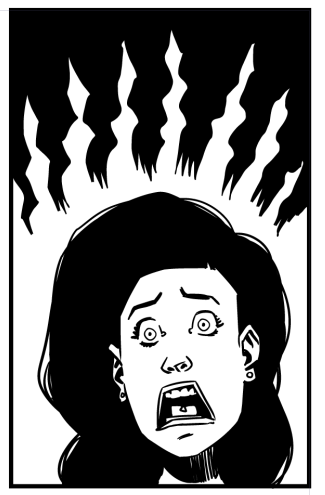
And some art for a pitch thing! Hurrah!
Now just a five part 20 pages thing to finish, a seven page thing I promised someone ages ago, and uhm… I think I was doing inktober.
There’s a few terms you’ll need to know:
Spotting Blacks – this is the process where-in you decided where to place black ink on the page. Spotting blacks well can make a page pop, steer the readers eyes and make the page finished.
If you’re unsure about where to spot blacks on the page, best thing to do is grab a big fat marker and spot some blacks on a reduced photocopy of the art.
BWS – Black With Stars – a pencilled instruction, indicating to the inker that you want Black – WITH STARS. Stars are often done with white ink on black – and, unless there’s a very specific look you’re after, it’s far easier to leave that to the inker (I’ve seen some pencillers who will ink certain bits of the stars they want because they’re after a specific thing).
X – X marks the spot. To be filled with black ink. and X in a bit of open pencils usually indicates the penciller wants that area to be filled with ink.
Dead line – no, not that one. A dead line in inking is a line that’s got not variety of thickness. Dead lines tend to look lifeless and flat (hence ‘dead’) and are to be avoided on anything really.
Tools:
Nib Pens – There’s a whole bunch of nibs worth picking up, and an inkers arsenal will often have a variety of sizes and “bounce”. Nibs can be stiff, or soft, and this will fall down to your preference. The most common nibs are:
Kuratake G Nib – A stiff nib for general line inking.
Hunt 102 – A fine lined, stiff nib – good for detail.
Hunt 107 – a fine lined, soft nib – good for detail. Pick one based on your preference.
A good inker can ink with pretty much anything, and each tool will do something different, but these are a fine set of nibs to start from. Here’s a decent set (ask for it for xmas! http://amzn.to/2ykKOXz )
A new nib will need cleaned (it’s covered in a protective film) either wash it with warm soapy water and dry thoroughly, or burn it off with a lighter (just a quick swipe with the flame should do it).
If you don’t, it’ll likely work fine, but it may take a little while to settle down.
You’ll also need to buy a pen holder.
Brushes – best advice on brush inking is to buy a variety of tools and try them all. Some people will be comfortable with a thicker brush and some with a thinner. The brush offers the best of all inking tools, but can be a devil to get right.
It can make even the dullest straight line look organic and attractive.
Here’s a video I made on using a ruler with a brush or a nib to rule a straight line (it’s a surprisingly uncommon bit of knowledge)
https://www.youtube.com/watch?v=WftBA4BbaSM
Brush use:
The brush has a number of component parts: The tip, the body, the ferrule (the metal bit joining the brush to the handle) and the handle.
When inking, avoid getting ink near the ferrule – anything there can dry and harden and ruin the brush (never through away a ruined brush as you can still use it to get some interesting textures)
Wash the brush frequently in clean water. I dry it by twisting the whole brush as I draw it down over some tissue (kitchen roll is best)
This is one of my favourite brushes (amazon has it a bit pricey, you can buy these cheaper locally, I’m sure) http://amzn.to/2ylB1jV
But more brush artists prefer a larger brush like this Winsor and Netown Sable Brush http://amzn.to/2ynvGpL
Nibs and brushes though often considered the best option, aren’t the only thing, there’s a lot of great pens available – where you can you want to stick to something water and light resistent, I’ve used some of these in the past:
Zebra Brush Pen – one of my favourite inking tools, flexible, always ready, waterproof and apparently lightfast. I’ve used the Medium pen here, and I’ve just ordered a set of various sizes and excited to play with them. http://amzn.to/2ypEqvL
Micron Pigma Pens – these come in a variety of sizes, which is just as well, as unlike brushes (or brush pens) these can only give you a sort of dead-line though you can get a fair amount of variety if you repeatedly go over a line with a pen and introduce different thickness.
Pretty great for drawing background details though where the dead line isn’t always a drawback.
Just be careful to get original micron pens, as there’s a bunch of counterfeit options out there that aren’t as lightfast nor as good. Here’s a full set to play with http://amzn.to/2ypln4B
Here’s a few files to play with (from mine and Rob William’s story “Nurture” published by 2000AD.) I’ve given you what the pencils and inks look like as well as blue line versions of the pencils and blue line versions of the inks. If you’re feeling brave, print the pencil bluelines and ink that. If that’s a little daunting (and it is because my pencils are pretty sloppy) then print the blue lined inks and try inking from those. Let me know how you get on!
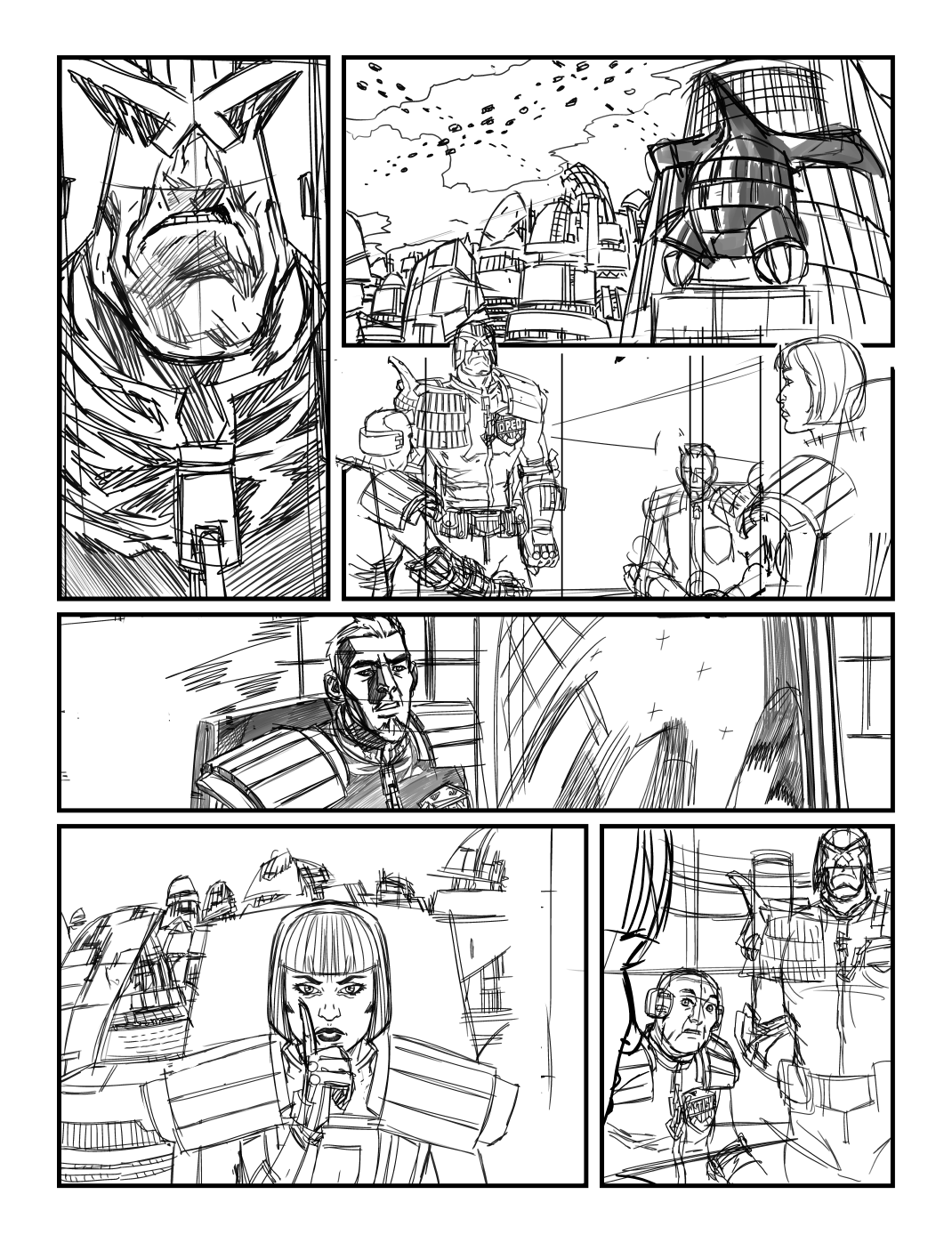
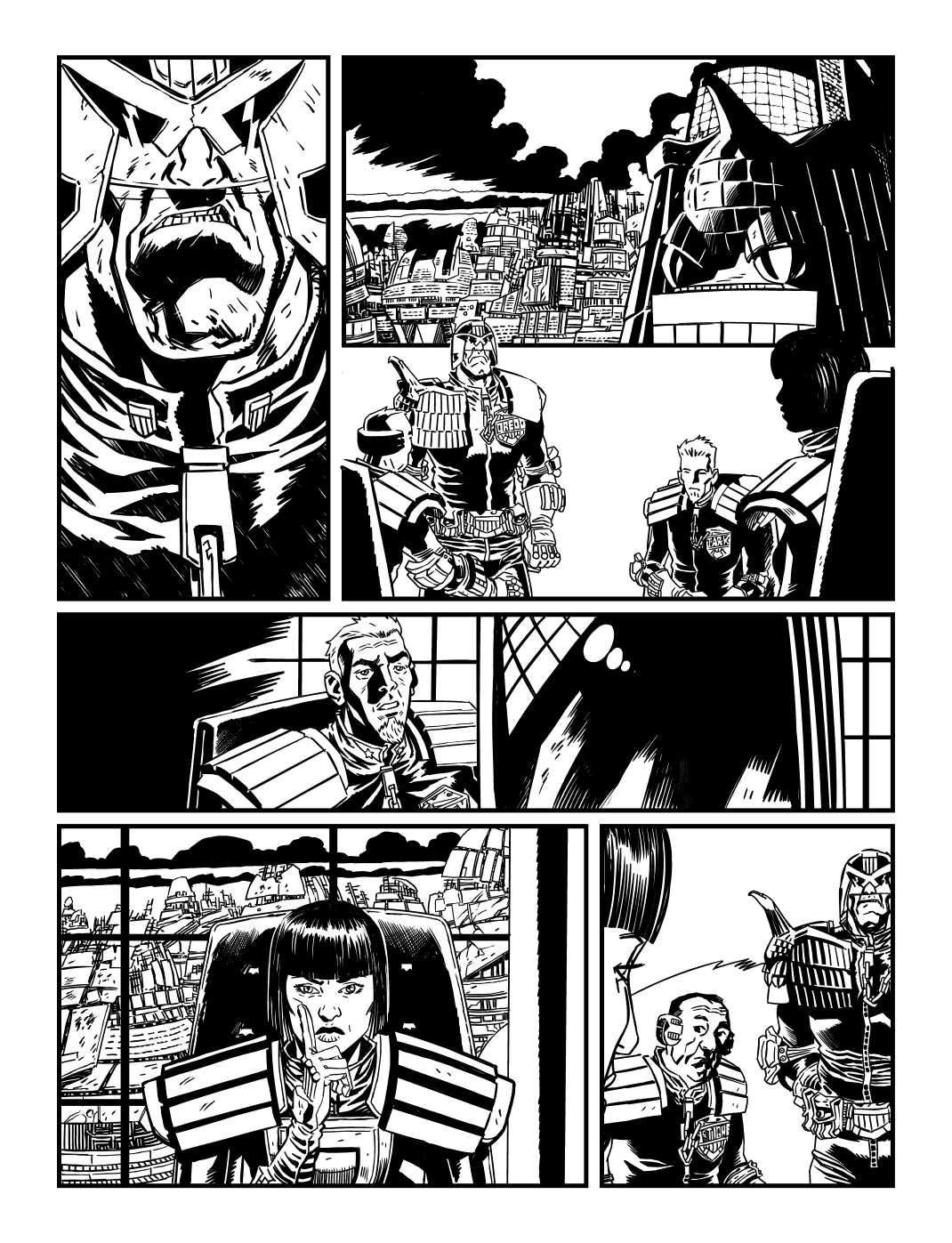
1. Know the horizon line and the eye level. They amount to the same thing, except the horizon line is the furthest point in the distance (where the horizon would be if the world were completely flat and didn’t have mountains/lakes or buildings in the way) and the eye level is a line that runs exactly through the horizon line except it’s where you’ve placed the viewer of your image, so represents as close as you can get to the viewer.
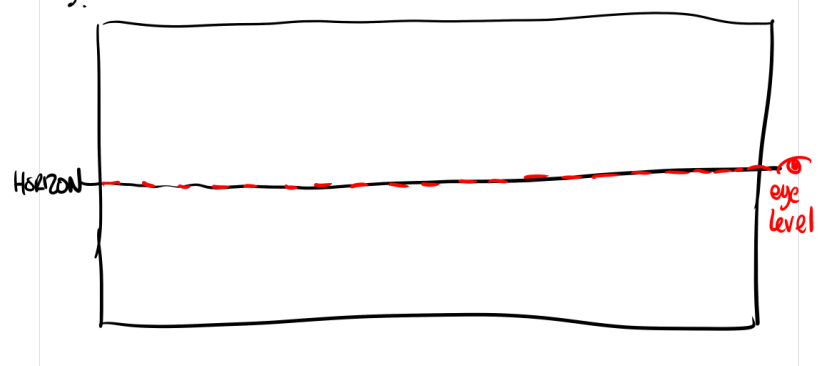
(A wobbly horizon and wobblier eyeline, but just imagine one is going right through the other!)
2. Things that are closer to the eye line are larger. Things that are further from the eye line are smaller! (I know, this is remarkable stuff!). When you’re dealing with drawings though, this isn’t quite enough, because, who’s to say that two squares floating in space, one smaller than the other in 2D aren’t just two different sized squares floating side by side? Then you need to bluff.
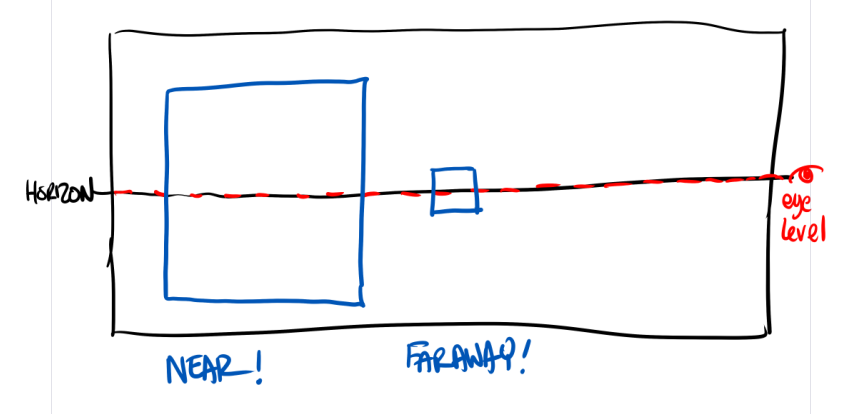
3. Overlapping helps your brain organise which items are in front of and behind other objects. Overlap a large square over a small square and it looks like the small square is much further away (join the squares up at the corner and voila! a cube!)
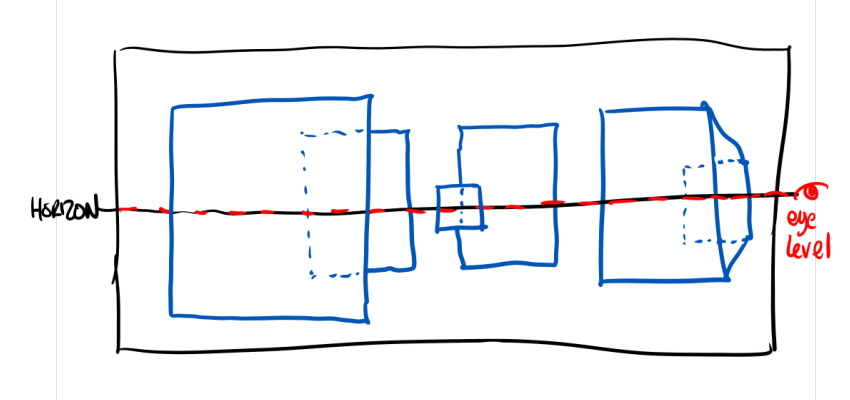
4. Use the eyeline as a way to hang things the same height as the eye line – so if your eyeline is 5’4″ (I’M SHORT – DEAL WITH IT) up then anything that hits that eyeline will appear 5″ 4′. It’s just the way our brains handle it.
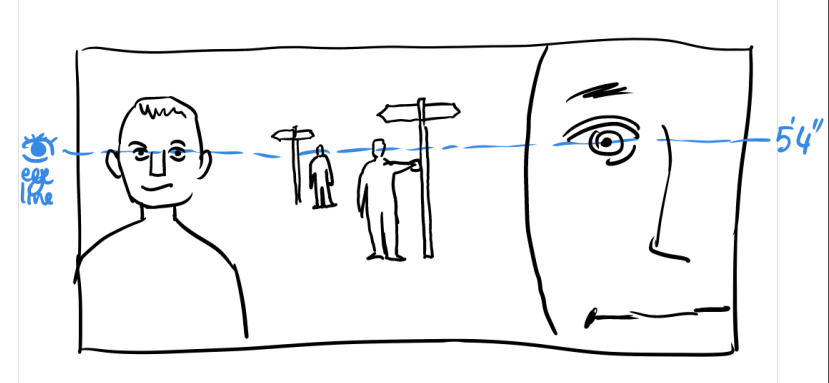
5. If something is taller or shorter than the eye line, figure out where the eyeline would intersect it and place all your objects where on the eyeline where the intersect.
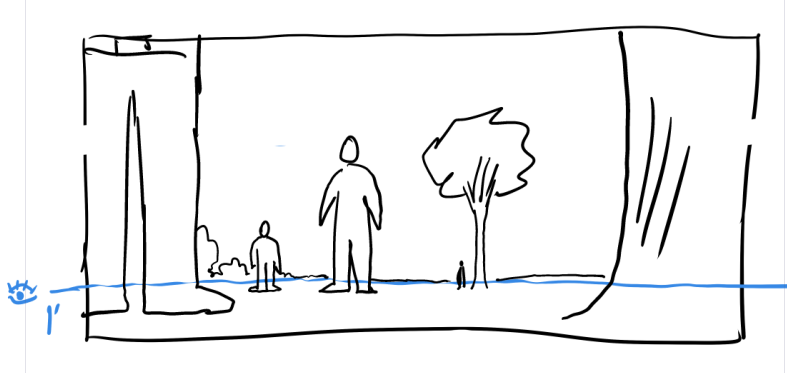
That’s it. You don’t need no steenking vanishing points.
I’m going to be delving into these topics in much more serious depth, BUT only for patreons, I’m afraid. If this is the kind of knowledge you want then sign up for the Backstage pass. I’ve limited numbers of $5 passes so if you’re in early you’re paying half. Otherwise it ten bucks.
I think perspective is a subject that too many people are afraid off because it very quickly becomes an exercise in technical drawing. You’re drawing hundreds of lines for guides before you get to do anything creative. But I’m pretty sure there’s an awful lot of stuff you can do without playing that game. Join me and you’ll see.
You hear that a lot in comics.
Done is better than perfect.
It’s like any aphorism, there’s always counter examples:
Done perfectly is better than done. And no-one remembers how long a project takes, only whether it’s any good or not.
But Done Perfectly is hard, and for every project done perfectly there’s a thousand unfinished, not-quite-there projects that are never finished. (and it’s a dead cert that the people making it don’t think it’s done perfectly)
Last year, when I began acting again, I did Macbeth (minor, but fun role) and I thought ‘God, I’d love to do an adaptation of Macbeth – as a grand sweeping sci-fi space opera, but keeping Shakespeare’s dialogue entirely intact’.
A designed a couple of characters – Macbeth, the witches, Duncan – basing it on things I thought would look amazing (touching on Aubrey Beardsley, Kirby, Charles Rennie MacIntosh, and more)
And then… well, I realised it’s gonna be over 300 pages (at least a years worth of work), and may be just out of my grasp artistically and who on earth would pay me to do it?
This month, though, doing one-page-a-day comics (setting a maximum time limit of 45 minutes of so, though I haven’t kept count, so it’s possible I blew that up) I’ve discovered I can draw enjoyable to read and draw comics that don’t require the same time/effort/perfectionism as my day job.
And, as a fun experiment I thought I’d apply that to the first page of the Macbeth strip. And, you know what, it worked. In so much as I got one page finished of a 300 page project that I was never gonna draw.
Will I do more? Maybe. Maybe next month after inktober, if the mood takes me and things settle down (even stealing a one hour out of my day is taking me off things I need to be doing).
Anyhue, here’s Macbeth, the sci-fi space epic, first page. If I do more it’ll be behind the paywall, because, well, it’s got to be some value for money for people here, right?
(I had intended to properly interrupt the story with the ad, but decided to get back to it. Ad many appear in the back of any print comic…)
Recent Comments